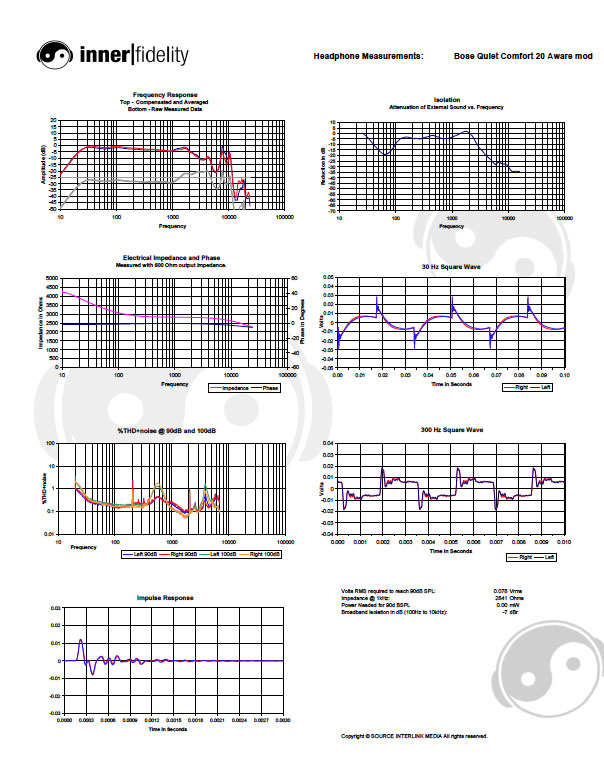| Columns Retired Columns & Blogs |
A Traveler's Sanctuary: The Bose Quiet Comfort 20 Noise Canceling Earphone Measurements
Measurements (noise canceling active)


Click on graphs image to download .pdf for closer inspection.
Compensated frequency response plot shows a headphone with a very linear response between 30Hz and 2kHz, with normal subsequent dip, and then a peak at 10kHz that does not exceed the line drawn from 30Hz to 2kHz. Other than maybe 5dB more response at 6kHz, response to 10kHz is near ideal. Response above 10kHz should be about 15dB higher; these cans do lack air and finesse above 10kHz.
You'll notice bass is nicely extended and flat to 30Hz, but the 30Hz square wave has a dramatic downward curvature. This indicates to me that while response is good to low frequencies, there is also significant phase shift in the bass. THD+noise plots in the bass show a gentle rise, but not so much that one would expect a thick, distorted bass. In listening I did find the bass well extended and strong, but lacked that last bit of punch realized with tight, in-phase bass response.
The leading edge of the 300Hz square wave is quick and has an appropriate overshoot, but the following 0.001 sec of the waveform is a bit grungy before setting down. This can also be seen in the impulse response with a clean initial pulse, but subsequent noise is somewhat excessive. In listening tests I heard this as a "papery" and somewhat grainy sound. It's important to note that I've regularly seen much worse noise in these plots, and feel that Bose has actually done a remarkable job controlling these cans in the time domain. Considering the amount of electronics and DSP going on here, I'd say these measurements are very good results.
While there is a mild distortion peak at 500Hz in the 100dBspl THD+noise plot, distortion levels in general are low and quite good. This plot might indicate some mid-range distortion at high listening levels, but I didn't observe this during listening tests—it's likely somewhat masked by the more obvious troubles with the treble grunge.
Electrical impedance and phase plot show the control module having about 3 kOhm input impedance when activated, and modest electrical phase shift.
The broadband isolation measured (100Hz - 10kHz) of the QC20 and QC15 are identical at -26dB—the best of all noise cancelers I've measured to date. The QC15 does better in the lowest and highest frequencies, but the QC20 provide a more even attenuation over all. I preferred the isolation of the QC20 over the QC15; it just seemed more natural and better.
With 93mVrms needed to reach 90dBspl I found myself running the volume controls up pretty high, but I think most folks will get plenty of volume from these in portable applications...especially since the background noise is so well attenuated.
The Bose QuietComfort 20 measures spectacularly well for a noise canceler!
Measurements of the QC20 in Other Modes
Click on graphs image to download .pdf for closer inspection.
As you can see, all measured parameters remain unchanged in Aware Mode with the exception of the amount of isolation. The isolation plot shows virtually no attenuation of outside noise from 100Hz to 2kHz permitting the full range of the human voice including speech intelligibility cue to be audible. Some attenuation of the bass and mid-treble and up is also present. It seems to me this is a good formula for hearing others while reducing some rumble and hiss.
Click on graphs image to download .pdf for closer inspection.
Passive mode performance of the QC20 shows a significant reduction in bass response below 100Hz; mid-range response becomes more uneven. Overall, a course pass on a moderately well balanced response, and heard that way.
30Hz square wave has poor shape, and little energy left by the end of the waveform, echoing the steep <100Hz roll-off of the bass frequency response.
300Hz square wave show lack of leading edge spike, and is heard as having a muffled treble relative to active mode. Confirmation to me yet again that some leading edge overshoot is desirable.
Impulse response shows a less responsive initial pulse, and more subsequent noise. THD+noise measurements also significantly increase. Comparing these measurements with the QC20 in active mode is convincing evidence that Bose did a good job with the headphone correction component of their DSP software.
Impedance and phase plots don't tell me much except that the signal is probably capacitively coupled, and that the primary driver resonance is likely just under 2kHz.
I find the isolation plot in passive mode quite interesting. Generally, the QC20 StayHear+ tip provides little isolation in the low and mid-frequencies, which doesn't surprise me in the least, but isolation above 2kHz seem to be reduced with the noise canceling active. I suspect high frequency isolation is actually remaining unchanged, but additional noise from the noise canceling circuits are appearing.
- Log in or register to post comments






































